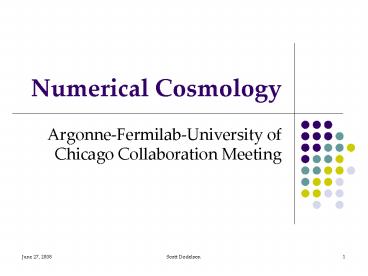Numerical Cosmology - PowerPoint PPT Presentation
Title:
Numerical Cosmology
Description:
Numerical Cosmology Argonne-Fermilab-University of Chicago Collaboration Meeting – PowerPoint PPT presentation
Number of Views:338
Avg rating:3.0/5.0
Title: Numerical Cosmology
1
Numerical Cosmology
- Argonne-Fermilab-University of Chicago
Collaboration Meeting
2
Need Simulations to Extract Science from Surveys
- Dark Matter
- Dark Energy
- Neutrino Mass
- Inflation
- Gravitational Instability is nonlinear
- Baryons governed by hydrodynamics
- Radiation Field affects and is affected by
structure - Stars form, Supernovae explode,
3
Progress
1000 Core Cluster at New Muon Lab
ANL LDRD
KICP, TAG Investments
DOE Dark Energy Grant
FRA Grant
Spring 07 Summer 07 Fall 07 Winter 08 Spring 08 Summer 08
Task Force Report
560 Core Cluster at New Muon Lab
DOE Lab Meeting
Presentation to PAC
4
Projects Using the Cluster
- Tinker, Kravtsov et al. 2008, ApJ in press
http//arxiv.org/abs/0803.2706 "Toward a halo
mass function for precision cosmology the limits
of universality" The project has used the
KICP/FNAL cluster for analyses of billion
particle cosmological simulations aimed at
calibrating predictions for halo mass function
and its evolution to an accuracy of a few per
cent. Figures 6 and/or 7 from the above paper can
be used to illustrate results of the project. - Brant Robertson, Andrey Kravtsov have used the
cluster to perform simulationsof dwarf galaxy
mergers with dark halos. The project is aimed
at exploring possible morphological signatures of
such "phantom mergers" to constrain incidence
of pure dark halos using available data. The
draft of a paper is being prepared for
submission (planned submission in the next
several months). - Konstantinos Tassis, Nick Gnedin, Andrey
Kravtsov are using the cluster to run the first
cosmological simulations of galaxy formation
with 3D radiative transfer, molecular hydrogen
formation on dust and its self-shielding from
dissociating radiation. The simulations are
using a model for star formation that is based on
molecular hydrogen. Gnedin, N. Y., Tassis,
K., Kravtsov, A. V., in preparation
"Molecular-Hydrogen-Based Star Formation
Prescription for Cosmological Simulations" - Brant Robertson, Andrey Kravtsov, Jeremy Tinker
are using the cluster to run Monte Carlo
calculations of mass functions and bias of dark
matter halos in different models for halo
collapse (using different collapse barriers to
reproduce simulation results). The aim of the
project is to understand the barrier required to
reproduce the simulation results and
implications for halo formation. - Robyn Levine, Nick Gnedin, Andrey Kravtsov,
Andrew Hamilton (Univ. of Colorado) are running
simulations of the circumnuclear region of a
supermassive black hole within a cosmological
volume. The goal of this project is to understand
the formation and evolution of supermassive
black holes and their feedback on large-scale
distribution of mass in the universe. Levine,
R, Gnedin, N. Y., Hamilton, A. J. S., Kravtsov,
A. V., ApJ in press http//arxiv.org/abs/0711.
3478 "Resolving Gas Dynamics in the
Circumnuclear Region of a Disk Galaxy in a
Cosmological Simulation" Levine, R, Gnedin, N.
Y., Hamilton, A. J. S., Kravtsov, A. V., in
preparation "Matter Transport in the Host
Galaxy of a Supermassive Black Hole - Maria Beltran, Wayne Hu have used the cluster for
calculating some MCMC chains for a work in
progress about the impact of future BAO surveys
on the determination of the isocurvature
amplitude of the curvaton and the degeneracies
in two other cosmological parameters the
equation of state of the DE and the spatial
curvature. - Marcos Lima, Hiroaki Oyaizu, Wayne Hu run N-body
simulations of f(R) modified gravity to study
the impact on nonlinear growth of structure and
help distinguish modified gravity from dark
energy models. The interesting results is that
such models have a unique signature in P(k) at
k0.1h/Mpc because gravity is stronger outside
halos (so there is more power on those scales
compared to LCDM). The effect is shown in Fig.
11 of the paper (http//yummy.uchicago.edu/misc/
methodpaper.pdf) H. Oyaizu, "Nonlinear
evolution in f(R) cosmologies I Methodology",
in prep. H. Oyaizu, M. Lima, W. Hu, "Nonlinear
evolution in f(R) cosmologies II Power
Spectrum", in prep. M. Lima, H. Oyaizu, W. Hu,
"Nonlinear evolution in f(R) cosmologies III
Halo abundance and bias", in prep. - Qizhi Zhang, Steve Kulhmann, Peter van Gemmeren
(ANL) use the cluster to manage the SQL
database for the DES-related simulation work. - Douglas Rudd, Andrey Kravtsov have been running
cluster simulations for convergence studies
within the framework of an international Galaxy
Cluster Comparison Project. - Ben Dilday is working on the measurements of the
type-Ia SN rate from the SDSS-II SN Survey.
Dilday, B, et al, "Rate of type-Ia SNe at zlt0.25
from the SDSS-II SN Survey" Dilday, B, et
al, "Rate of type-Ia SNe in galaxy clusters from
the SDSS-II SN Survey" both in prep. - Sheng Wang is modeling CMB anisotropies in
modified gravity models. Fang et
al.,"Challenges for the Self-accelerating
Braneworld Model on the Horizon from the CMB",
in prep. - The VERITAS group at U of Chicago is using the
cluster to run simulations of very-high-energy
gamma rays hitting the atmosphere and being
reconstructed by our detector. These
simulations will have an important impact in all
the VERITAS papers under preparation.
5
E.g. Was Einstein Right?
- Marcos Lima, Hiroaki Oyaizu, Wayne Hu run N-body
simulations of f(R) modified gravity to study
the impact on nonlinear growth of structure and
help distinguish modified gravity from dark
energy models. - H. Oyaizu, "Nonlinear evolution in f(R)
cosmologies I Methodology", in prep. - H. Oyaizu, M. Lima, W. Hu, "Nonlinear evolution
in f(R) cosmologies II Power Spectrum", in
prep. - M. Lima, H. Oyaizu, W. Hu, "Nonlinear evolution
in f(R) cosmologies III Halo abundance and
bias", in prep.
6
Particle Astro Physics and the Brain
Symmetry
Litke
Ermentrout
7
Exploratory Meeting (June 2007)
- Dodelson (FNAL) with Murray Sherman (Chair, Dept.
of Neurobiology, UC) Sam Sisodia (Director,
Center for Neurobiology, UC) . Suggested two step
process - Invite Visiting Committee (e.g. Abbott, Koch,
Woody, Litke) to FNAL/UC to scout out areas of
overlap 5-10k - Highlight these areas in joint workshop 20k































